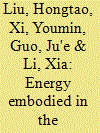| Srl | Item |
| 1 |
ID:
117304


|
|
|
|
|
| Publication |
2013.
|
| Summary/Abstract |
A substantial amount of primary and secondary energy is consumed by the residential sector. Residential energy consumption includes energy required for construction activity and household consumption. Hence there is a need to quantify energy consumption, its significance and causes. Calculating energy intensity of goods and services is the first step towards quantifying the causes. This research is based on the 115 sector classification input-output tables for India, for 1993-94, 1998-99 and 130 sector classification input-output tables for 2003-04 and 2006-07. Energy intensity of sectors related to household consumption has been calculated to analyze the trend between 1993-94 and 2006-07. Indirect energy requirements of Indian households have been assessed in this study from calculations of total primary energy intensity along with private final consumption expenditure. Results indicate that energy consumption has increased for all categories except "medical care and hygiene". Percentage increase in indirect primary energy consumed by households is maximum for "house building" and "recreation" categories. Finally a complete decomposition analysis of indirect primary energy consumed by households has been carried out based on changing structural composition of the private final consumption expenditure, energy intensity patterns, per capita expenditures on energy and population.
|
|
|
|
|
|
|
|
|
|
|
|
|
|
|
|
| 2 |
ID:
097204


|
|
|
|
|
| Publication |
2010.
|
| Summary/Abstract |
Growing international trade has not only positively affected the People's Republic of China's (China's) economic development, but also expanded the exportation of energy embodied in goods during their production. This energy flow out will pose risks to China's rational utilization of natural resources as well as environmental protection. In this paper, we evaluate the energy embodied in goods produced in China during 1992-2005 and use input-output structural decomposition analysis to identify five key factors causing the changes of energy embodied in exports. (Direct primary energy efficiency, primary energy consumption structure, structure of intermediate inputs, structure of exports, and scale of exports.) For the three sub-periods of 1992-1997, 1997-2002, and 2002-2005, results show that China is a net exporter of energy, and the energy embodied in exports tends to increase over time. The expanding total volume of exports and increasing exports of energy-intensive goods tend to enlarge the energy embodied in exports within all three sub-periods, but these driving forces were offset by a considerable improvement of energy efficiency and changes in primary energy consumption structure from 1992 to 2002 and the effects of structure of intermediate input only in the sub-period from 1992 to 1997. From 2002 to 2005, the sharp augmentation of energy embodied in exports was driven by all the five factors. Our research has practical implications for the Chinese economy. Results of this study suggest that the energy embodied in trade should receive special attentions in energy policies design to limit the energy resource out-flow and pollution generation.
|
|
|
|
|
|
|
|
|
|
|
|
|
|
|
|